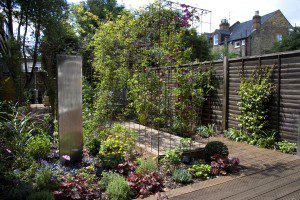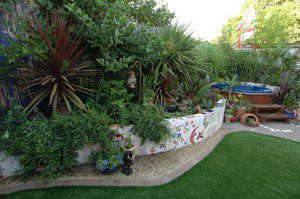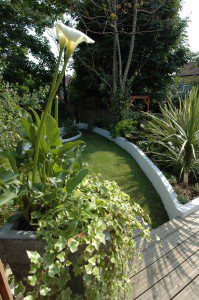Designing a planting scheme

Designing a planting scheme in the garden is usually the aspect at the forefront of most people’s minds when planning a redesign. Naturally, botanical interest is the predominant feature that most people associate with gardens, although there have been many gardens, albeit a lot of them conceptual, that do not contain plants. Plants can help define a garden, soften the edges, accentuate the features and support the layout. They can show the user where to walk, where to look, what senses to employ in certain areas and define how they should feel in a space.
Soft blousey planting schemes with heady scents conjure up romantic notions, while willowy grasses moving in the breeze may remind the user of a slightly wilder place. Tropical, architectural planting schemes can transport the person to tropical climes whilst a chic, monochrome scheme may remind more of a stylish urban setting. Either way there are a few golden rules when designing with plants.
What plant to put where? Make sure you plant them in their preferred setting. Most retailers supply plants with care labels which will give instructions on the best place, and time of year, to install them. Failing that you should be able to find all the information you need online. It is vital to consider not only the aspect and conditions of the plant, but also its expected maximum size.
Most people wouldn’t dream of planting a tree right next to their house, but some large shrubs can be just as troublesome in terms of large root systems encroaching on house foundations, or expanding growth blocking doorways or restricting light to the house interior. Some plants self-seed or throw up new shoots away from the main plant, which could prove problematic if you have a small space or wish to keep things neat and tidy.
Whilst some plants will put on a ‘to die for’ show they may have an exceptionally short flowering period, so think carefully about using these plants in abundance as you may be left with gaps in large areas of your garden once flowering is over. Try to plan plants for the winter and choose some plants that will give colour and form to your garden during the colder months. Don’t underestimate the beauty of berries and the majestic nature of frosted seed-heads – they all add value to the winter garden.
Using a few plants varieties can often create a much bigger impact in a small space than saturating a garden with a plethora of species. Colour themes are a simple way of solidifying a scheme, so select plants from across one colour palette to create a huge impact, or use contrasting or complimentary colours on the colour wheel to impart a sense of drama or harmony.
The technique of colour balancing helps to set the tone for the garden, using complimentary colours creates a restful, harmonious atmosphere, while contrasting colours will enliven the space and stimulate the senses. An all-white planting scheme such as the one at Sisley will seem to glow at night, while an all-green scheme will create a lush tropical feel. If you are after a modern-looking scheme experiment with textures using box balls and lavender, thistles and grasses, as a diversity of texture can be just as important as colour.
Whatever planting style you choose there is plenty of advice to be had from good garden centres and specialist growers. Talk to them and ask their advice, and spend time planning your planting scheme rather than impulse buying.



